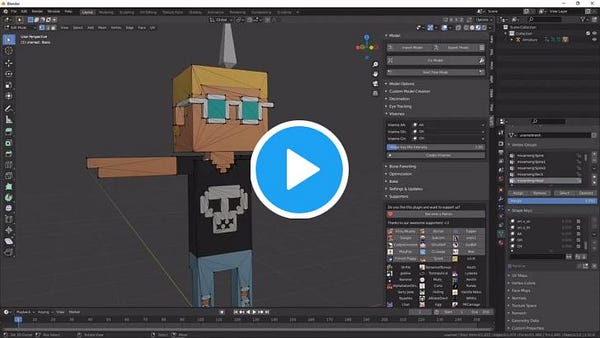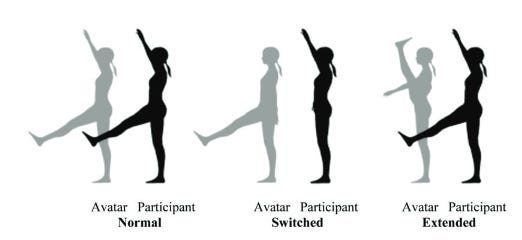Attention Reader: If you like Accelerated Capital, consider doing one or more of the following:
Donate to our wallet address: acceleratedcapital.eth
Vote for us in the Mirror $WRITE Race.
Subscribe to this Newsletter.
Follow us on Twitter.
Table of Contents 🕹️
Introduction
The Body Electric
The Proteus Effect
The Hero with a Thousand Faces
The Descent
“We know what we are, but not what we may be.”
-William Shakespeare, Hamlet
I. Introduction 👾
In Hinduism, an avatar is the material manifestation of a deity on earth. The literal meaning of the Sanskrit noun is “descent, alight, to make one’s appearance”. The descent is symbolic for the transition “from eternity into the temporal realm, from unconditioned to the conditioned, from infinitude to finitude.”
There are many stories in Hinduism of Vishnu and his multiple forms. He manifested on earth frequently to restore cosmic balance between the ever-present forces of good and evil. Through the act of descent, Vishnu embodied the avatar - his eternal consciousness materialized in a tangible form.
Modern computing uses the term ‘avatar’ for the graphical representation of a user in 2D or 3D space. The earliest use of the term in a video game setting was the 1979 PLATO RPG Avatar (more from us on the history of games here). However, the modern definition stems from the 1985 release of Ultima IV: Quest of the Avatar, in which the playable character is supposed to be the actual real-world player manifested in the game. The developer Richard Garriot made this narrative choice to create an ethically-nuanced plot: if the player and the character are the same, then the player should be responsible for the ethical choices made in-game.
This week’s issue asks what association is there between a person and the avatar they wear? When a human transitions from the temporal realm of meatspace into the infinitely varied yet always limited realm of cyberspace, how does the relationship to their avatar evolve?
II. The Body Electric 👾
Thomas Nagel, in his seminal essay “What Is It Like to Be a Bat”, argues that consciousness cannot be fully explained without recognizing the subjective characteristic of experience. To explain consciousness via objective and reductive proofs would require discarding the feeling behind experience.
Bats use echolocation to navigate similar to a human’s eyesight. Since sonar and vision are both perceptual, there is something it’s like to experience them. It’s possible as a human to imagine flying around, eating insects, hanging upside down, and navigating by sonar, but we aren’t able to fully capture the “essence” of doing so.
But maybe that isn’t correct.
Recent research on immersive virtual reality shows that avatar embodiment can transform perceptual experience in ways that challenge Nagel’s insight.
Between 1989 and 1999, researchers tested how participants adapted to a number of increasingly strange nonhuman avatars. It was found that by mapping degrees of freedom to the human body, participants were able to learn to control these nonhuman avatars effectively, even though they were radically different from their own. For example, a human could learn to move the eight-legs of an octopus avatar by rotating their wrists. This ability for the human mind to adapt to the body it is in is called homuncular flexibility.
This flexibility is naturally observed after an amputation. The brain effectively remaps the body to account for the change. If the remap isn’t successful, phantom limb syndrome can occur, resulting in sensation within the non-existent limb. In a 1996 paper, Ramachandran and Rogers-Ramachandran showed it was possible to fix the phantom limb phenomenon by assisting the brain with remapping:
Patients were asked to place their uninjured limb in a box with a mirror in the midline and to position their head to look in the mirror so that moving their uninjured limb resulted in the illusion of two normally moving limbs. Thus, the cortical map which had been distorted due to the lack of real input from the missing limb could be restored by the visual input of a plausible limb in the location of the amputated limb.
In similar experiments, stroking a rubber hand on a table in front of a participant while simultaneously applying sensation to their out-of-sight hand resulted in strong feelings of association. So much so that they would flinch when the rubber hand was endangered or harmed.
If a rubber hand is enough to trick the brain, then virtual reality is surely effective. And this was found to be the case: the rubber hand experiments have been recreated in VR.
However, it gets really interesting when non-human avatars are used. For example, one experiment showed humans could acquire deep bodily attachments to virtual tails using visuomotor synchrony, resulting in measurable feelings of fear in response to threats to the artificial appendage.
So we can trick the brain into inhabiting bodies different from our own, but how well does it subsequently perform?
Two experiments from Stanford attempted to explore just that.
Experiment 1
The first experiment altered the relationship between tracking and rendering the body. During a game where participants were asked to hit a series of floating targets using their hands and feet, one group of participants received 1:1 body mapping in the virtual environment whereas the experimental group had inverted tracking (e.g. leg movement would translate to arm movement) or adjusted mobility ranges (e.g. a slight foot movement correlated to a large movement).
Within 10 minutes, participants were able to make the necessary adjustments, modifying their natural behavior to meet the needs of the modified condition.
Experiment 2
In the second experiment, the researchers wanted to answer how well a human subsequently performs in a newly-adapted body.
Participants were asked to play a VR game where they attempted to hit three targets in front of them with their hands. Two targets were easily accessible by the left and right hands via natural movement. The third target was further in front, meaning under normal conditions the participant would have to step forward and reach out to hit it. The performance of a control group was compared to an experimental group where participants were given 3-armed avatars, with the third arm slightly longer than normal and controlled by moving the wrist of the left arm.
The result? While participants were initially slow, they were able to ultimately outperform relative to the control group. The brain became efficient enough at operating the three-armed avatar to perform better at the task than its own natural body.
More intuitive controls could lead to even better performance:
III. The Proteus Effect 👾
I can add colors to the chameleon,
Change shapes with Proteus for advantages- William Shakespeare, King Henry VI
The natural flexibility of the mind in adjusting to a virtual body isn’t the only exciting aspect of avatars and digital identity. The virtual self is extremely customizable; users of avatars can shape their bodily appearances and personas as they see fit.
In human culture, there are myriad tales of shapeshifting entities. From Loki, the trickster god of the Nords - to Kitsunes, the transforming foxes of Japanese lore - to the Greek god Proteus, prophetic ruler of the sea: the human imagination has long been fascinated by a supernatural ability to transform appearances.
Nowhere is self-transformation more possible though than in the digital realm. Just look to the seemingly infinite customizable traits of video game avatars as an example.
The Proteus effect is a psychological phenomenon in which the behavior of an individual changes to reflect the characteristics of their avatar. This can be a modest change, such as a person becoming loquacious while wearing an attractive skin, or a significant change, such as in the 1998 study by Frank and Gilovich that saw subjects wearing black uniforms becoming more aggressive than their white uniform-wearing counterparts.
Yee and Bailenson explored the Proteus effect in a set of experiments using a collaborative virtual environment, or CVE. A CVE is a communication system where multiple interactants share the same 3D digital space despite being in remote locations. In this environment, researchers are able to manipulate how two participants perceive one another without them knowing.
In a CVE, every user perceives their own digital rendering of the world and each other, and these renderings need not be congruent. In other words, the target may perceive his or her own avatar as being attractive, whereas the perceiver sees the target as being unattractive.
By tracking the physical distance between participants and the number of times they disclosed personal information, the researchers observed that individuals wearing more attractive avatars were willing to be physically closer and disclose more personal information to their counterpart. This it what one would expect if the Proteus Effect were true. Interestingly, this effect occurred almost immediately after putting on the avatar and seeing themselves in a mirror.
In another experiment, the researchers were able to show that individuals who inhabited taller avatars showed increased confidence during negotiations. This is in line with prior research. Again, the effect became pronounced almost immediately upon seeing their virtual avatar.
The Proteus Effect could have an enormous impact on a digitized society. Most avatars tend to be of above-average attractiveness. Does this mean our future interactions may be more personable, affectionate, and intimate in these virtual spaces? What impact could this have on an individual that decides to wear a grotesque or villainous avatar for a prolonged period?
IV. The Hero with a Thousand Faces 👾
Social interaction is increasingly moving toward virtual environments. Web3 technologies enable an interoperable, spatial web capable of porting identities across platforms. In this new environment, our identity moves beyond the scattered bits of data collected by service providers to a cohesive whole available on-chain.
This explains why exorbitant sums of money are exchanged for certain avatars. They express something that the individual wants to convey about who they are as a person.
In a recent public forum, David Caffrey and Sillytuna were discussing Sillytuna’s Cryptopunk Alien #7523. Sillytuna was contemplating what it will feel like to retire his cryptopunk after using it as his identity for so long. If the human mind can adapt to different avatar bodies and gain the associated personality traits, could it also become emotionally attached to being that avatar?
It’s an interesting question.
And while we could grow attached to a single avatar, our identities are more fluid in the web3 era. We could change who we are with the switch of a wallet address. New avatar, new persona, new social life. Anonymity and pseudonymity will likely proliferate as individuals customize their identities for the social situation at hand. This can already be seen with the rise of anons and alt-accounts.
Also of note, on mediums like Twitter, collectors of NFTs change profile avatars on a regular cadence, trying on whole new personas in the process. Some of these NFT avatars can extend beyond one single instance or platform.
This idea was recently brought to the forefront with the release of Meebits. There are 20,000 unique Meebits on the Ethereum blockchain. Owners of a Meebit NFT are given a full 3D model that can be rendered and animated across the Metaverse. Taking your avatar between video games and virtual worlds means we will be more connected to them than we have ever been before.


V. The Descent 👾
While anyone can wear multiple faces in the web3 world, the reverse is also true: many people could wear one face.
Lil Miquela is a character created by Trevor McFedries and Sara DeCou in 2016. According to Wikipedia, Lil Miquela’s social media accounts:
[…] detail a fictional narrative which presents Miquela as a CGI character and model in conflict with other digital projects while marketing a variety of brands, primarily in fashion. As a marketing tool, Lil Miquela has been featured in product endorsements for streetwear and luxury brands such as Calvin Klein and Prada.
Lil Miquela is part of a trend where communities of people operate behind a single avatar.
Consider VTubers.
Kizuna AI is currently the largest Japanese VTuber with more than 10 million subscribers across a variety of content channels. Her content is similar to many other YouTubers, consisting of discussions, Q&A, and "Let's Play" videos. She also streams regularly, performs in real concerts, and gives interviews on television. Kizuna AI is directly managed by Activ8, the company that created her.
The technology underlying Kizuna AI is thought to be MikuMikuDance. Production crews design a 3d model with the software and breathe life into it via a voice actor and motion capture technology.
Multi-sig wallets could ultimately enable avatars like Lil Miquela or Kizuma AI to be governed by a community or DAO. Groups of people could use a single avatar to represent them throughout the Metaverse. One could use the governance tokens of a DAO to verify partial ownership of an avatar NFT, allowing any community member to create content with or otherwise use that character.
For more on the potential of multi-sig wallets and their inventory primitive characteristics within the Metaverse, check out the piece by Kei Kreutler here.
Avatars can extend beyond individual or community ownership though. iNFTs are non-fungible tokens embedded with machine learning GPT-3 prompts as part of the smart contract code being developed by Alethea AI. This creates intelligent, scalable, generative, interactive, and networked NFTs built with state-of-the-art language models to facilitate learning. Some use cases:
Someday virtual worlds like Decentraland or Cryptovoxels might be filled with intelligent NFT avatars alongside real people. iNFTs could become so convincing that it would be difficult to distinguish between a human and synthetic consciousness.
Ultimately, the Metaverse will have a profound impact on identity. Anyone can become anything and their mind will adapt, going so far as to evolve into the persona of the body it inhabits. Whole communities could operate behind a single avatar. Individuals could change their identity as easily as changing their clothes.
Maybe in the end we come full circle: god-like artificial intelligences descend like Vishnu into avatar bodies to participate in our world.
In any case, the hero wears a thousand faces in the Metaverse. Which one will you choose?
Be sure to subscribe to our newsletter below and follow us on Twitter to remain on the bleeding edge of the Web3 revolution.
In each issue, we’ll explore how cryptoassets, DeFi, virtual reality, and other exponential technologies are transforming our economy, society, and culture.












